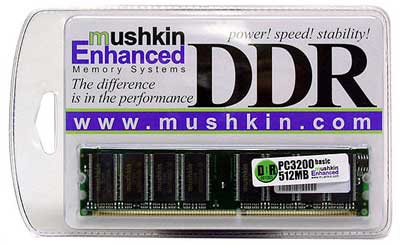Buyer's Guide - Mid-Range, October 2004
by Jarred Walton on October 21, 2004 11:00 AM EST- Posted in
- Guides
Memory Recommendations
While many might disagree with this assessment, we are going to increase the RAM recommendation for our Mid-Range Guide to 1 GB, regardless of what type of work you use it for. The truth is that a lot of users do not need more than 512 MB of RAM, but as long as we're being truthful, few people really need something faster than the systems in our Entry Level Guide. If you're willing to spend more money for the added performance and "future-proofing" of faster processors and other components, it doesn't make a lot of sense to skimp on the RAM. This also allows us to avoid recommending 256 MB DIMMs, which we feel are now only an option for the value-minded consumer.As we mentioned in our past Guides, performance does not differ a whole lot between the various manufacturers, and reliability is generally good with any of the major brands. We recommend spending a few dollars extra to get a reputable brand instead of settling for generic RAM. Should any of your DIMMs fail, it is easier to get the advertised "lifetime warranty" honored. Whom do we consider reputable? Well, any of the major brands that we have reviewed in our past RAM articles should be safe: Corsair, Crucial, GEIL, Kingston, Mushkin, OCZ, Samsung and several others. Those should all work well, so on whichever you can get the best price is a good choice.
Our RAM recommendation is going to be split into a Value and a Performance choice. The Value RAM will have higher latencies, but the difference in speed is typically less than 5%. For those willing to spend a little more, the Performance option is there. Those who are interested in getting into the world of overclocking are advised to spend more money on their RAM, as it is often the limiting factor. It is worth mentioning, however, that the cost of high-end RAM can often be more than the cost of the next faster processor, and a faster processor will usually provide more tangible benefits. Reliability is rather difficult to determine, but on the whole, we see fewer problems with expensive RAM than with value RAM. Then again, most hardware failures tend to come from other sources than the RAM; for instance, flaky power supplies and/or motherboards. Keeping your system free from dust will go a long way towards avoiding component failure in our experience.

Value DDR Recommendation: 2x512MB Mushkin PC3200 2.5-4-4
Price: $150 Shipped
We have never had any serious problems with Mushkin RAM, and at $150, the cost of 1 GB of RAM is very reasonable. In fact, users who routinely work on extremely large files in Photoshop might even decide to simply max out their memory system with 4x512 MB DIMMs. Most people don't need that much RAM, but if you do, you already know it. Gamers and software developers should be content with 2x512MB for the next year at least, and the option to add more RAM is always there if you need it.
We do not feel that 1GB DIMMs are really an option yet, since even the cheapest non-generic DIMMs cost over $200. However, anyone interested in trying to reach the advertised 4GB maximum of current systems might take a look at OCZ's 1GB DIMMs. That's not even a remotely mid-range configuration, though - it's more of a moderate server setup. At some point in time, we will actually see a shift to 64-bit OSes running 4GB or more of RAM, but that day is probably at least a couple years off for most users.

Performance DDR Alternative: 2x512MB OCZ EL 2-3-2-6 1T
Price: $224 Shipped
Those looking to gain a bit in performance and lower their memory latency should look at the 2-3-2 RAM options that are out there. While 2-2-2 RAM might be fractionally faster, it costs a bit more. OCZ has impressed us with the quality and reliability of their RAM in the past couple years - for a company that was once considered a "generic" brand, that's saying a lot! The heat spreaders are not really necessary, but they do make your RAM look attractive for those who have windowed cases.
Should you want to go for something a little faster, or perhaps you might want some RAM that could be overclocked at some point in the future, then we recommend Crucial Ballistix PC3200 RAM. Capable of 2-2-2 1T timings up to 220 MHz or so, and with the option to go even higher with relaxed timings, Crucial Ballistix is a great choice for high-end RAM.










54 Comments
View All Comments
PrinceGaz - Thursday, October 21, 2004 - link
pg.3 under AMD CPU Alternative: "The 3400+ is also an option for additional performance and at 2.4 GHz, it is only slightly slower than the 3800+ at roughly half the cost. Our past tests have shown that the additional 512K of L2 cache does not usually boost performance of the Athlon 64 processors as much as an additional 200 MHz of clock speed will, so we recommend the Newcastle cores over the Clawhammer variants"It should be 3700+ rather than 3800+ as we are talking about S754 processors.
HVAC - Thursday, October 21, 2004 - link
I think you should revise the comments on the price of the hard drives to reflect 58 and 59 cents per GIGAbyte, not per MEGAbyte.JClimbs - Thursday, October 21, 2004 - link
Good article, I like seeing multiple choices and reading the +'s and -'s for each.Tides - Thursday, October 21, 2004 - link
you mention ocz for 220 bucks but a gig of pqi @ 2-2-2-5 (TCCP samsung chips) goes for 30more which as we've seen in your own reviews does awesome.